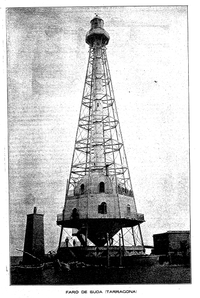Isla de Buda
| Isla de Buda | ||
|---|---|---|
| Isla de Buda (landing stage) | ||
| Waters | Ebro , Balearic Sea | |
| Geographical location | 40 ° 42 '8 " N , 0 ° 51' 9" E | |
|
|
||
| length | 4.1 km | |
| width | 1.3 km | |
| surface | 7.52 km² | |
| Residents | uninhabited | |
The Isla de Buda is an island at the eastern end of the Ebro Delta . It belongs to the Parque natural del Delta del Ebro and communally to the municipality of Sant Jaume d'Enveja , in the Comarca Montsià , province of Tarragona in Spain . With an area of 752 hectares and a length of five kilometers, it is the largest island in Catalonia .
geography
The island is formed at the transition between the sea coast and the river bank from the alluvial soil and pushes from west to east into the Balearic Sea . The island has a roughly triangular plan with a point in the south, where a former spit forms the south coast of the island from south to northeast. The Spit has completed the lagoons Cajon Grande (also: cajón de Arriba, Catalan. : Calaix Gran / de Dalt ) and Calaix de Mar ( Calaix de Baix ) included. The north-eastern point is the Cabo de Tortosa , on which the Faro de Buda lighthouse used to stand. An arm of the Ebro flows there, separating the island from its northern neighbor, the Isla de San Antonio . The northern bank of the island forms the main arm of the Ebro, while the Lo Migjorn branch runs from the western tip of the island to the south and separates the island from the mainland.
The lagoons in the interior of the island form an important habitat for birds, which is why the island can only be entered with a special permit. Rice is still grown on the island. The few residential and farm buildings are on Carretera del Far , which runs along the north bank.
history
In 1924 the island of Buda was acquired by the current owners of the northern half, the Borés family, while the southern half is owned by the Department of Medi Ambient de la Generalitat de Catalunya . In 1945 the Catalan poet Josep Maria de Segarra stayed on the island. In the 1950s the island had about 200 inhabitants in about 40 families who settled there to grow rice . There was a band, a school, and a soccer team. Today only two families live on the island.
Faro de Buda lighthouse
The old Faro de Buda lighthouse was a steel structure designed by John Porter from Birmingham . It was built in 1864 according to plans by the Spanish architect and engineer Lucio del Valle . It was in service for about 100 years until it was destroyed by a storm in 1961. The large tower with a height of 53 m was built on an uninhabited sandbank. Together with the lighthouses El Fangar and La Baña , the Faro de Buda formed a system for marking the Ebro estuary. The construction with an anchoring by threaded blocks (screw-pile lighthouse) was an important innovation at that time.
For advertising purposes, del Valle had a 1:20 model (5% of the original size) made. The model was made in Barcelona and exhibited at the 1867 World's Fair in Paris. It is kept at the Polytechnic University of Madrid .
The Faro de Buda after a drawing by José Eugenio Ribera .
Photography from the Revista de Obras Públicas .
literature
- Faro de la Isla de Buda. in: Revista de Obras Públicas 1861, no. 9, t I (4): 55–56.
- Lucio del Valle : Proyectos de torres de hierro para los faros del Ebro. In: Revista de Obras Públicas 1861, no.9, t. I (10): 121-130.
- Lucio del Valle: Proyectos de torres de hierro para los faros del Ebro (conclusión). In: Revista de Obras Públicas 1861, no.9, t. I (11): 133-138.
- Lucio del Valle: Faro de Buda. In: Revista de Obras Públicas 1897, no.44, t. I (1124): 355-357.
- José Eugenio Ribera Dutaste : Faro de hormigón armado en Larache. In: Revista de Obras Públicas 1935, no.83, t. I (2667): 157-158.
Individual evidence
- ↑ Faro de la Isla de Buda. In: Revista de Obras Públicas 1861 no.9, t. I (4): 56.
- ↑ José Eugenio Ribera Dutaste: Faro de hormigón armado en Larache. In: Revista de Obras Públicas 1935, 83, t. I (2667): 157-158.
- ↑ José Eugenio Ribera: Puentes de hierro económicos, muelles y faros sobre palizadas y pilotes mecánicos. 1895 Librería Editorial de Bailly-Bailliere e Hijos, Madrid: 299 (Lámina XIII).
- ↑ Lucio del Valle Arana: Faro de Buda. Revista de Obras Públicas 1897, no.44, t. I (1124): 361.




